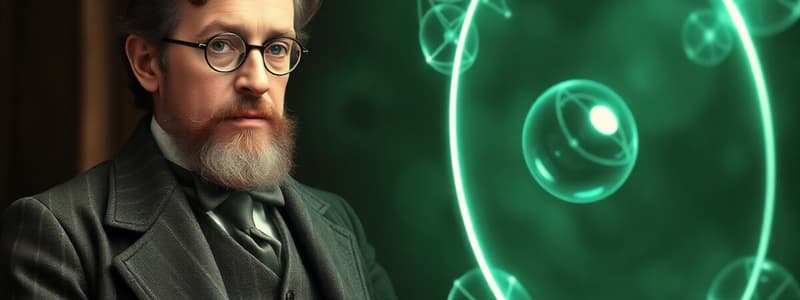Podcast
Questions and Answers
What is a primary conclusion of the atomic theory?
What is a primary conclusion of the atomic theory?
- Atoms can be created or destroyed.
- All matter is made of atoms. (correct)
- Atoms can be divided into smaller particles.
- All atoms are of different elements.
Which statement is true regarding atoms of different elements?
Which statement is true regarding atoms of different elements?
- They can be transformed into each other.
- They are composed of the same kind of atoms.
- They have the same mass.
- They are different from each other. (correct)
What does the Law of Conservation of Mass state?
What does the Law of Conservation of Mass state?
- Mass only decreases during chemical reactions.
- Mass always increases in chemical reactions.
- Mass changes but matter cannot be created or destroyed. (correct)
- Matter can be created and destroyed.
What did John Dalton propose about atoms?
What did John Dalton propose about atoms?
What was J.J. Thomson's contribution to atomic theory?
What was J.J. Thomson's contribution to atomic theory?
What did Ernest Rutherford demonstrate about the atom?
What did Ernest Rutherford demonstrate about the atom?
Using a Cathode Ray Tube, what did J.J. Thomson conclude about the light beam?
Using a Cathode Ray Tube, what did J.J. Thomson conclude about the light beam?
What is a compound composed of?
What is a compound composed of?
Flashcards are hidden until you start studying
Study Notes
Atomic Theory
- All matter is composed of atoms.
- Atoms are indivisible.
- All atoms of the same element are identical.
- Atoms of different elements differ from each other.
- Compounds form when two or more elements combine.
Law of Conservation of Mass
- Matter cannot be created or destroyed, only transformed.
- The mass of a substance never changes, but its weight can change due to gravity.
John Dalton
- Proposed the Atomic Theory, suggesting that atoms are indivisible and solid, positively charged spheres.
- Dalton's experiments determined that substances are composed of specific proportions of atoms.
- His model is known as the Billiard Ball Model.
J.J. Thomson
- Discovered electrons (negatively charged particles) within a positively charged solid sphere.
- Thomson's model is known as the Plum Pudding Model.
- Used the Cathode Ray Tube to demonstrate that a positively charged plate attracts a beam of light, proving that the beam must be negatively charged.
- He called the negatively charged particles "corpuscles," later named electrons.
Ernest Rutherford
- Demonstrated that atoms have a positively charged nucleus containing most of the atom's mass, surrounded by empty negative space.
- His experiments used alpha particles to bombard gold foil.
Studying That Suits You
Use AI to generate personalized quizzes and flashcards to suit your learning preferences.




